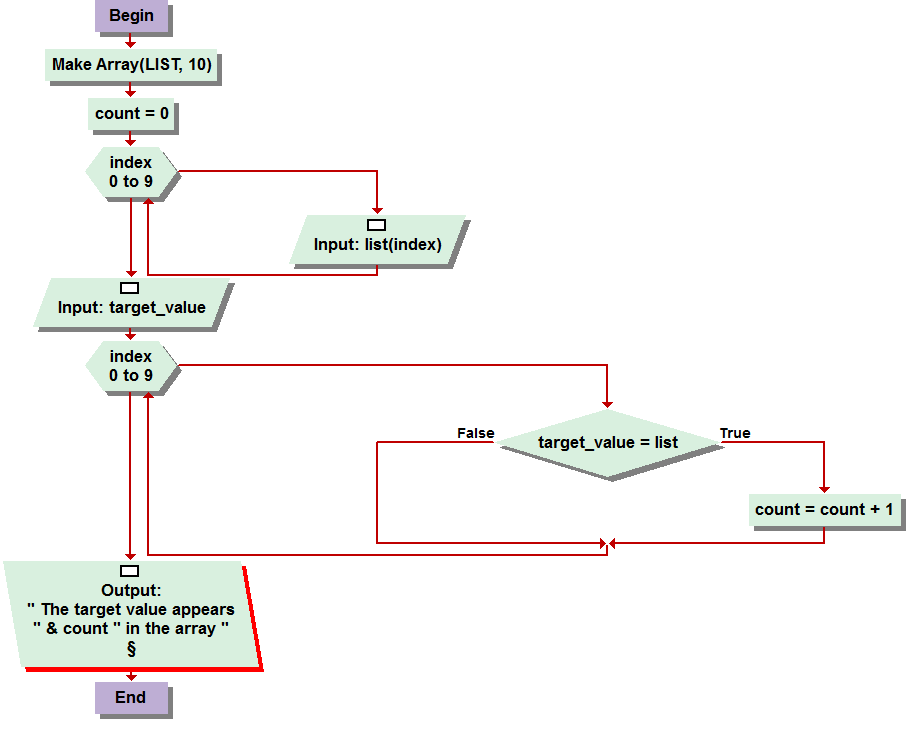Programs Like Visual Logic Array
Start Visual Logic and add the Make Array shape. Double-click the Make Array shape to open its dialog. In the Array Name text box, enter colors. In the Upper Bound text box, enter 2. Note that array indexes start at zero. So this array will have indexes 0, 1 and 2. That is what we need to hold the three colors. Visual Logic Problem, Please Help! - posted in Software Development: Write a program that reads in a list of positive integers from the user until the user enters the value –1 as a sentinel. At that time the program should display the largest value in the input list. So I think I have the first part figured out, ending when you input -1.
A programmable logic array (PLA) is a kind of programmable logic device used to implement combinational logiccircuits. The PLA has a set of programmable AND gate planes, which link to a set of programmable OR gate planes, which can then be conditionally complemented to produce an output. It has 2N AND Gates for N input variables, and for M outputs from PLA, there should be M OR Gates, each with programmable inputs from all of the AND gates. This layout allows for many logic functions to be synthesized in the sum of products canonical forms.
PLAs differ from Programmable Array Logic devices (PALs and GALs) in that both the AND and OR gate planes are programmable.
History[edit]
In 1970, Texas Instruments developed a mask-programmable IC based on the IBM read-only associative memory or ROAM. This device, the TMS2000, was programmed by altering the metal layer during the production of the IC. The TMS2000 had up to 17 inputs and 18 outputs with 8 JK flip flop for memory. TI coined the term Programmable Logic Array for this device.[1]
Now it is possible to determine the size of the 3D-Map by yourself. Isometric map definition.
Implementation procedure[edit]
- Preparation in SOP (sum of products) form.
- Obtain the minimum SOP form to reduce the number of product terms to a minimum.
- Decide the input connection of the AND matrix for generating the required product term.
- Then decide the input connections of OR matrix to generate the sum terms.
- Decide the connections of invert matrix.
- Program the PLA.
PLA block diagram:
| 1ST BLOCK | 2ND BLOCK | 3RD BLOCK | 4TH BLOCK | 5TH BLOCK |
|---|---|---|---|---|
| INPUT BUFFER | AND MATRIX | OR MATRIX | INVERT/ NON INVERT MATRIX | FLIP FLOP OUTPUT BUFFER |
Advantages over read-only memory[edit]
The desired outputs for each combination of inputs could be programmed into a read-only memory, with the inputs being loaded onto the address bus and the outputs being read out as data. However, that would require a separate memory location for every possible combination of inputs, including combinations that are never supposed to occur, and also duplicating data for 'don't care' conditions (for example, logic like 'if input A is 1, then, as far as output X is concerned, we don't care what input B is': in a ROM this would have to be written out twice, once for each possible value of B, and as more 'don't care' inputs are added, the duplication grows exponentially); therefore, a programmable logic array can often implement a piece of logic using fewer transistors than the equivalent in read-only memory. This is particularly valuable when it is part of a processing chip where transistors are scarce (for example, the original 6502 chip contained a PLA to direct various operations of the processor[2]).
Applications[edit]
One application of a PLA is to implement the control over a datapath. It defines various states in an instruction set, and produces the next state (by conditional branching). [e.g. if the machine is in state 2, and will go to state 4 if the instruction contains an immediate field; then the PLA should define the actions of the control in state 2, will set the next state to be 4 if the instruction contains an immediate field, and will define the actions of the control in state 4]. Programmable logic arrays should correspond to a state diagram for the system.

The Commodore 64 home computer released in 1982 used a '906114-01 PLA' to handle system signals.[3]
See also[edit]
References[edit]
- ^Andres, Kent (October 1970). A Texas Instruments Application Report: MOS programmable logic arrays. Texas Instruments. Bulletin CA-158.
- ^How MOS 6502 Illegal Opcodes really work
- ^arcadecomponents.com - Commodore 906114-01 64 PLA IC
External links[edit]
- 'Programmable Logic Array (PLA)'. cmsc311. University of Maryland. 2003.
- 'PLA (programmable logic array)'. Java Applet. University of Hamburg.
- вторник 25 февраля
- 11
